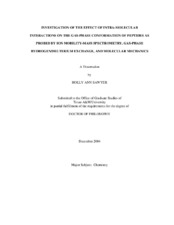| dc.description.abstract | Ion mobility-mass spectrometry (IM-MS), gas-phase hydrogen/deuterium (H/D) exchange ion molecule reactions and molecular modeling provide complimentary information and are used here for the characterization of peptide ion structure, including fine structure detail (i.e., cation-π interactions, β-turns, and charge solvation interactions). IM-MS experiments performed on tyrosine containing tripeptides show that the collision cross-sections of sodiated, potassiated and doubly sodiated species of gly-gly-tyr are smaller than that of the protonated species, while the cesiated and doubly cesiated species are larger. Conversely, all of the alkali-adducted species of try-gly-gly have collision cross-sections that are larger than that of the protonated species. The protonated and alkali metal ion adducted (Na+, K+ and Cs+) species of bradykinin and bradykinin fragments 1-5, 1-6, 1-7, 1-8, 2-7, 5-9 and 2-9 were also studied using IM-MS and the alkali metal ion adducts of these species were found to have cross-sections very close to those of the protonated species. Additionally, multiple peak features observed in the ATDs of protonated bradykinin fragments 1-5, 1-6 and 1-7 are conserved upon alkali metal ion adduction. It was observed from gas-phase H/D ion molecule reactions that alkali adducted species exchange slower and to a lesser extent than protonated species in the tyrosine- and arginine-containing peptides. Experimental and computational results are discussed in terms of peptide ion structure, specifically the intra-molecular interactions present how those interactions change upon alkali salt adduction, as well as with the sequence of the peptide.
Additionally, IM-MS data suggests the presence of a compact conformation of bradykinin fragment 1-5 (RPPGF) when starting from organic solvent conditions. As water is added stepwise to methanolic solutions, a more extended conformation is populated. When the starting solution is composed of ≈90% water, two distinct mobility profiles are observed as well as a shoulder, indicating the presence of three gas-phase conformations for RPPGF. Gas-phase H/D exchange of [M+H]+ ions prepared from aqueous solvents show a bi-exponential decay, whereas samples prepared from organic solvents show a single exponential decay. The effect of solvent on gas-phase peptide ion structure, i.e., solution-phase memory effects, is discussed and gas-phase structures are compared to know solution-phase structures. | en |


